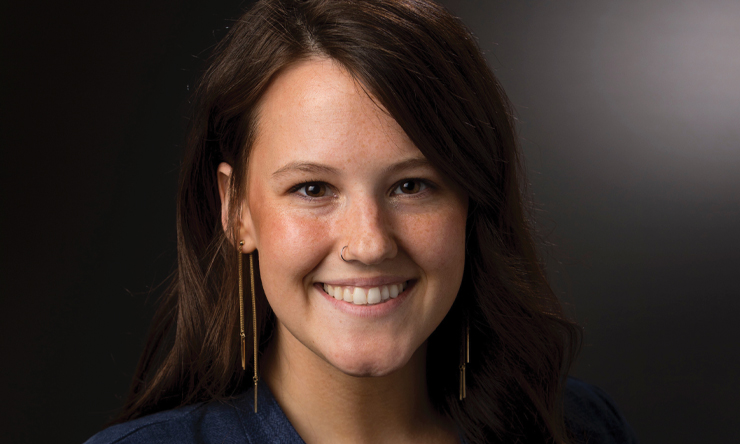On September 4, 1882, a day with a clear sky and the temperature in the high 60s, thirty-three boys walked into two classrooms of St. Marguerite's Cathedral grade school at Eleventh and Iowa Streets in Davenport, Iowa. They were the first students, on the first day, of St. Ambrose Seminary.
There was no public notice that something lasting had begun that day. There had been no advertisement in the newspaper announcing the opening of a new school for boys; apparently the news had spread from the pulpits of local Catholic parishes. And there was no news story in the days following saying that school had begun. The first mention of the school came in October when Bishop John McMullen, who had been away, was interviewed by the local newspaper.
So begins 1966 alumnus Father George McDaniel's history of St. Ambrose, "A Great and Lasting Beginning." One need but read only a few pages to reach a few conclusions: It was a remarkable time filled with remarkable people, such as the ailing bishop of a newborn diocese with a keen, far-reaching vision, and a young priest ready to make that vision reality. Less than 20 years before, America had emerged from a civil war as a country where the pursuit of happiness, liberty and justice for all were at their most manifest. And the nation was growing, more than just in people. Their dreams, too, were without boundaries, and all was possible.
The thirty-three boys who walked in that morning were just that, boys. They ranged in age from twelve to twenty-three but most were between thirteen and sixteen. Most lived in the Cork Hill neighborhood near the school, so called because of the large number of Irish immigrants in the area. Most had one thing in common: they were the sons of immigrants.
All of their immigrant parents had arrived in the United States by the Civil War. Immigrants of this generation left Europe for a variety of reasons, economic opportunity being the most common. But the Germany and Ireland of the 1840s and 1850s were also awash with social and political conflicts. In Ireland, groups like Young Ireland and the Fenians were fighting for independence from England. In Germany, various groups, including the "48ers," were fighting for liberal reform. The turmoil of these conflicts and the possibility of being drafted into someone's army drove people to leave their homelands. So for many reasons immigrants came to Davenport. In 1885, in the city of Davenport, with a population of 23,830, 25.7 percent of the population had been born in Germany and 4.6 percent had been born in Ireland.
Whatever dreams the fathers and mothers of these thirty-three St. Ambrose sons had, education was a key to realizing those dreams. McMullen expressed some of those hopes when he wrote thirty years earlier, that it was the "paramount" duty of parents to provide a Catholic education that would "respect faith and morals, but which at the same time... fit its subject for intellectual contact with their fellow men in the sphere of life they may be called to occupy." Certainly as immigrant parents they hoped the education their sons received at St. Ambrose would better prepare them to take advantage of the opportunities offered in the United States and become members of the rising middle class.
St. Ambrose began at a time when American educators, religious and secular, were beginning to question the proper curriculum of a college. For most of the early part of the century, college curricula emphasized the basic liberal arts. Catholic colleges "endeavored by means of a religious training, mental discipline, and liberal culture, to produce the complete Christian character." In the years following the Civil War, however, American secular colleges began to develop curricula for studies in medicine, law, and engineering. Although McMullen was determined to be a part of that trend by establishing a law school and medical school at St. Mary of the Lake University in Chicago in the 1860s, most Catholic institutions like St. Ambrose continued to emphasize the "purpose of higher education was mental discipline" that would prepare its graduates to assume any position in life. Other than seminaries, there were only a handful of professional programs in Catholic colleges.
At St. Ambrose such debates were in the future, and all the thirty-three students of the new St. Ambrose Seminary understood was that summer was over and school had started. As they entered the building that morning, the boys were greeted by two faculty members, the twenty-four-year-old Reverend Aloysius J. Schulte, the president of the school, and twenty-year-old Joseph Halligan.
Schulte understood McMullen's vision for St. Ambrose. He believed that since human beings were both body and soul, education must join natural science, the knowledge of nature acquired by observations, with spiritual science, the knowledge of God's law imprinted in the heart or revealed by God. Both were an "integral part" of Christian education. Therefore, proper education must include the sanctification of the soul, the development of the intellect, and the promotion of physical welfare. The job of the educator was to "develop, train and cultivate all the faculties, moral, intellectual and physical," which would form students into Christian men and women ready to take their place in the world. According to Schulte, the fact that human beings were made for God was the core principle of education. Speaking in 1901, he said, "Religious teaching, impressions, and observances should penetrate all branches of education and instruction, of which they are not merely a part among other parts, but the soul and spirit diffused through the whole system. Religion does not merely run parallel to the course of secular studies, but like a vitalizing sap, should enter into and pervade every fiber of them."
To Schulte the teaching of history, art, literature, and science were windows to understand "God's dealing with mankind." Religion (theology) and its "handmaid," philosophy, were the core of this learning and as such they "lay down the fundamental principles of law, government and social order," which were necessary in "active as well as speculative pursuits, law and morals, to guide us in politics, in the liberal professions and in the business of everyday life."
The curriculum Schulte developed tried, as much as possible with only a faculty of two, to put those principles into practice at St. Ambrose. So Schulte taught the classics, but he also taught geology. He had no formal training in science, but he taught himself, found ways to equip a science laboratory, often from his own pocket, and worked to find other science teachers. Along with Francis B. Huot, one of the members of the first class, he built a geology collection of over 2,000 specimens, which was reportedly "one of the finest collections of geological specimens in the west." A later observer said that Schulte had "great plans for the future" of St. Ambrose. His style "back in the eighties, was distinctly of the progressive type; he did not confine the curriculum to the traditional classical training; there were up-to-date courses in modern science as well." He also visited other schools, studied their curricula, and familiarized himself with the latest trends in education. Schulte had a hand in every aspect of the early St. Ambrose. Years later he remembered, "If there were some cockleburs on the campus you might picture me pulling them up. We spent most of the first few years pulling up cockleburs."
The boys were not greeted on the first day by Bishop McMullen. At the time McMullen and Cosgrove had their conversation in the spring of 1882 about finding a place for a school for boys, the bishop had already contracted cancer. Just before the bishop's long diocesan tour in the fall of 1881, Cosgrove had commented that McMullen's "health seems not to be good." That tour in the fall, and a second tour in the early winter of 1881-1882, had "aggravated the disease that ended his life, for he was never in good health after." Writing a friend in January 1882, McMullen admitted that "I find that I have no longer the vigor of other days. At times I feel that my earthly pilgrimage is coming to a close... this winter has been very severe on me... pray that I may bear patiently whatever comes in the way of bodily infirmities and accept all with sincere resignation." Three months later McMullen wrote Eliza Allen Starr, "If the weather had been warmer I should be better now, but it is chilly and I am not so well."
McMullen appeared at commencement ceremonies at the Immaculate Conception Academy on June 29, 1882. He was too ill to stand and speak, so he offered his congratulations to the graduates from his chair. He told them he had hoped to invite them all to his house for a picnic, but that would have to wait until another time. According to Michael V. Gannon, the principal speaker that day, he also said he intended to start a school for boys, which may have been the first public announcement about the beginning of St. Ambrose.
In his absence, Cosgrove, Schulte, and Halligan opened the school, originally named St. John's College, in honor of the bishop. When McMullen returned, however, he objected, saying that while St. John was a great apostle, he was not an educator. Since this would be an educational institution, McMullen said, "I think we shall call it St. Ambrose," for the fourth-century Bishop of Milan and Doctor of the Church.
McMullen likely came to appreciate St. Ambrose during his days as a student in Rome. While there he wrote the manuscript about the rites and institutions of the early church which may well have included a section on the Ambrosian liturgical rite and Ambrose's role as a leader of the early church.
Upon his return to Davenport, McMullen gave a newspaper interview where he described the career of St. Ambrose as a "patron of education" and a "writer, architect and composer." He also discussed his own expansive, far-eyed vision to have St. Ambrose be a university for the entire upper Mississippi Valley, under the patronage of all the dioceses of the region. He stated that within the next year he hoped to find a larger, more centrally located site on which to erect a new building that would, with additions, accommodate hundreds of students.
Throughout the spring, life at St. Ambrose was tempered by the declining health of Bishop McMullen. He had left Davenport again in mid-December for the desert west where he remained until the beginning of March. When he returned to Davenport, he told his doctor that he knew he was dying, but, he said, "My books are balanced and I am ready for the journey... my time is now devoted to the entertainment and instruction of my friends." He visited the school when he could, and although by the end of April it was reported that he was "improved," he was "still very feeble." In mid-June he was able to go to Chicago to see old friends and family in what they, and he, must have known was a farewell visit. McMullen was on his deathbed when examinations took place in late June, and in deference to his condition, there was no commencement ceremony at the end of the year. However, there was not really anyone to "commence." Following examinations, several students were singled out for honorable mention but there were no degrees or diplomas granted.
McMullen died at age fifty-one on July 4, 1883, just after the school year ended. He left the school his vision of education and his hopes that St. Ambrose would play a significant role in the life of the church in his diocese and the upper Mississippi Valley. There was a sense of loss beyond the usual grief at a death. One priest who knew him said the bishop was "idolized" and that he "would have been the most remarkable bishop" in the United States. The students also noticed his absence. Writing a year later, one student said that during the second year they had "missed our kindly Father, his smiling face no more illumed the gloom of our study hall, there was a void within our hearts-a dark and dreary void-the ties of love were broken. The things went on as were before, but the Father dear was dead."
News
Share This Story



